A Hydrothermal Synthesis Process of ZSM-5 Zeolite for VOCs Adsorption Using Desilication Solution
Abstract
1. Introduction
2. Experimental
2.1. Materials
2.2. Synthesis of ZSM-5 Zeolite
2.3. Characterization and Analysis Methods
2.4. The Adsorption Testing Method
3. Results and Discussion
3.1. Effects of the Crystallization Reaction Time
3.2. Effects of the Crystallization Reaction Temperature
3.3. Effects of the Na2O/SiO2 Molar Ratio
3.4. Effects of the SiO2/Al2O3 Molar Ratio
3.5. Composition and Structure Analysis of ZSM-5 Zeolites
3.6. Static Adsorption Performance of ZSM-5 Zeolite for VOCs
4. Conclusions
Author Contributions
Funding
Data Availability Statement
Conflicts of Interest
References
- Bensafi, B.; Chouat, N.; Djafri, F. The universal zeolite ZSM-5: Structure and synthesis strategies. A review. Coord. Chem. Rev. 2023, 496, 215397. [Google Scholar] [CrossRef]
- Miyake, K.; Inoue, R.; Miura, T.; Nakai, M.; Al-Jabri, H.; Hirota, Y.; Uchida, Y.; Tanaka, S.; Miyamoto, M.; Inagaki, S.; et al. Improving hydrothermal stability of acid sites in MFI type aluminosilicate zeolite (ZSM-5) by coating MFI type all silica zeolite (silicalite-1) shell layer. Microporous Mesoporous Mater. 2019, 288, 109523. [Google Scholar] [CrossRef]
- Su, X.; Zhang, K.; Snatenkova, Y.; Matieva, Z.; Bai, X.; Kolesnichenko, N.; Wu, W. High-efficiency nano [Zn,Al]ZSM-5 bifunctional catalysts for dimethyl ether conversion to isoparaffin-rich gasoline. Fuel Process. Technol. 2020, 198, 106242. [Google Scholar] [CrossRef]
- Wang, F.; Chu, X.; Zhao, P.; Zhu, F.; Li, Q.; Wu, F.; Xiao, G. Shape selectivity conversion of biomass derived glycerol to aromatics over hierarchical HZSM-5 zeolites prepared by successive steaming and alkaline leaching: Impact of acid properties and pore constraint. Fuel 2020, 262, 116538. [Google Scholar] [CrossRef]
- Al-Jubouri, S.M.; Al-Batty, S.I.; Holmes, S.M. Using the ash of common water reeds as a silica source for producing high purity ZSM-5 zeolite microspheres. Microporous Mesoporous Mater. 2021, 316, 110953. [Google Scholar] [CrossRef]
- Lauridant, N.; Daou, T.J.; Arnold, G.; Soulard, M.; Nouali, H.; Patarin, J.; Faye, D. Key steps influencing the formation of ZSM-5 films on aluminum substrates. Microporous Mesoporous Mater. 2012, 152, 1–8. [Google Scholar] [CrossRef]
- Qi, T.; Teng, J.; Shi, J.; Chu, G.; Zou, H.; Luo, Y.; Zhang, L.; Sun, B. Synthesis of ZSM-5 zeolite by dynamic hydrothermal method with premixing in the rotating packed bed: An process mechanism analysis. Chem. Ind. Eng. Prog. 2021, 40, 6228–6234. [Google Scholar]
- Jafari, S.; Ghorbani-Shahna, F.; Bahrami, A.; Kazemian, H. Adsorptive removal of toluene and carbon tetrachloride from gas phase using Zeolitic Imidazolate Framework-8: Effects of synthesis method, particle size, and pretreatment of the adsorbent. Microporous Mesoporous Mater. 2018, 268, 58–68. [Google Scholar] [CrossRef]
- Wu, S.; Wang, Y.; Sun, C.; Zhao, T.; Zhao, J.; Wang, Z.; Liu, W.; Lu, J.; Shi, M.; Zhao, A.; et al. Novel preparation of binder-free Y/ZSM-5 zeolite composites for VOCs adsorption. Chem. Eng. J. 2021, 417, 129172. [Google Scholar] [CrossRef]
- Yang, C.; Miao, G.; Pi, Y.; Xia, Q.; Wu, J.; Li, Z.; Xiao, J. Abatement of various types of VOCs by adsorption/catalytic oxidation: A review. Chem. Eng. J. 2019, 370, 1128–1153. [Google Scholar] [CrossRef]
- Yuan, N.; Zhao, A.; Hu, Z.; Tan, K.; Zhang, J. Preparation and application of porous materials from coal gasification slag for wastewater treatment: A review. Chemosphere 2022, 287, 132227. [Google Scholar] [CrossRef]
- Qu, J.; Zhang, J.; Sun, Z.; Yang, C.; Shi, D.; Li, S.; Li, H. Research progress on comprehensive utilization of coal gasification slag. Clean Coal Technol. 2020, 26, 10–18. [Google Scholar]
- Chang, S.; Zhuo, J.; Meng, S.; Qin, S.; Yao, Q. Clean Coal Technologies in China: Current Status and Future Perspectives. Engineering 2016, 2, 447–459. [Google Scholar] [CrossRef]
- Wu, S.; Huang, S.; Wu, Y.; Gao, J. Characteristics and catalytic actions of inorganic constituents from entrained-flow coal gasification slag. J. Energy Inst. 2015, 88, 93–103. [Google Scholar] [CrossRef]
- Zhang, J.; Zuo, J.; Jiang, Y.; Zhu, D.; Zhang, J.; Wei, C. Kinetic analysis on the mesoporous formation of coal gasification slag by acid leaching and its thermal stability. Solid State Sci. 2020, 100, 106084. [Google Scholar] [CrossRef]
- Qu, J.; Zhang, J.; Li, H.; Li, S. A high value utilization process for coal gasification slag: Preparation of high modulus sodium silicate by mechano-chemical synergistic activation. Sci. Total Environ. 2021, 801, 149761. [Google Scholar] [CrossRef] [PubMed]
- Xue, T.; Liu, H.; Zhang, Y.; Wu, H.; Wu, P. Synthesis of ZSM-5 with hierarchical porosity: In-situ conversion of the mesoporous silica-alumina species to hierarchical zeolite. Microporous Mesoporous Mater. 2017, 242, 190–199. [Google Scholar] [CrossRef]
- Al-Jubouris, M. Synthesis of hierarchically porous ZSM-5 zeolite by self-assembly induced by aging in the absence of seeding-assistance. Microporous Mesoporous Mater. 2020, 303, 110296. [Google Scholar] [CrossRef]
- GAao, J.; Wang, W.; Zhang, J.; Lei, Z.; Shi, D.; Qu, L. Study on synthesis and adsorption performance of hydrophobic ZSM-5 zeolites for removal of toluene in high-humidity exhaust gas. J. Chem. Ind. Eng. 2020, 71, 337–343. [Google Scholar]
- Huang, X.; Wang, C.; Zhu, Y.; Xu, W.; Sun, Q.; Xing, A.; Ma, L.; Li, J.; Han, Z.; Wang, Y. Facile synthesis of ZSM-5 nanosheet arrays by preferential growth over MFI zeolite [100] face for methanol conversion. Microporous Mesoporous Mater. 2019, 288, 109573. [Google Scholar] [CrossRef]
- Bai, R.; Sun, Q.; Song, Y.; Wang, N.; Zhang, T.; Wang, F.; Zou, Y.; Feng, Z.; Miao, S.; Yu, J. Intermediate-crystallization promoted catalytic activity of titanosilicate zeolites. J. Mater. Chem. A 2018, 6, 8757–8762. [Google Scholar] [CrossRef]
- Li, X.; Wang, J.; Guo, Y.; Zhu, T.; Xu, W. Adsorption and desorption characteristics of hydrophobic hierarchical zeolites for the removal of volatile organic compounds. Chem. Eng. J. 2021, 411, 128558. [Google Scholar] [CrossRef]
- Mohiuddin, E.; Isa, Y.M.; Mdleleni, M.M.; Sincadu, N.; Key, D.; Tshabalala, T. Synthesis of ZSM-5 from impure and beneficiated Grahamstown kaolin: Effect of kaolinite content, crystallisation temperatures and time. Appl. Clay Sci. 2016, 119, 213–221. [Google Scholar] [CrossRef]
- Kimj, K.; Leeh, D. Effects of step change of heating source on synthesis of zeolite 4A from coal fly ash. J. Ind. Eng. Chem. 2009, 15, 736–742. [Google Scholar]
- Cheng, Y.; Liao, R.H.; Li, J.S.; Sun, X.Y.; Wang, L.J. Synthesis research of nanosized ZSM-5 zeolites in the absence of organic template. J. Mater. Process. Technol. 2008, 206, 445–452. [Google Scholar] [CrossRef]
- Sun, Y.; Ma, T.; Cao, S.; Wang, J.; Meng, X.; Gong, Y.; Zhang, Z.; Ma, A.; Liu, P. Defective sites in ZSM-5 zeolite synthesized by n-butylamine template facilitating uniform meso-microporosity by alkali-treatment. Microporous Mesoporous Mater. 2021, 326, 111360. [Google Scholar] [CrossRef]
- Kadja, G.T.M.; Suprianti, T.R.; Ilmi, M.M.; Khalil, M.; Mukti, R.R.; Subagjo. Sequential mechanochemical and recrystallization methods for synthesizing hierarchically porous ZSM-5 zeolites. Microporous Mesoporous Mater. 2020, 308, 110550. [Google Scholar] [CrossRef]
- Ismail, A.A.; Mohamed, R.M.; Fouad, O.A.; Ibrahim, I.A. Synthesis of nanosized ZSM-5 using different alumina sources. Cryst. Res. Technol. 2006, 41, 145–149. [Google Scholar] [CrossRef]
- Jiang, T.; Wang, F.; Zhang, X.; Zhai, Y.; Lv, G.; Shen, Y.; Wu, Y. Facile synthesis of ZSM-5 mesocrystal via novel pathway of crystallization: Fast precipitation, deconstruction and reorganization. Microporous Mesoporous Mater. 2021, 321, 111112. [Google Scholar] [CrossRef]
- Hamid, S.; Kumar, M.A.; Lee, W. Highly reactive and selective Sn-Pd bimetallic catalyst supported by nanocrystalline ZSM-5 for aqueous nitrate reduction. Appl. Catal. B Environ. 2016, 187, 37–46. [Google Scholar] [CrossRef]
- Xie, Y.; Cao, H.; Li, Y.; Zhang, Y.; Crittenden, J.C. Highly selective PdCu/amorphous silica-alumina (ASA) catalysts for groundwater denitration. Environ. Sci. Technol. 2011, 45, 4066–4072. [Google Scholar] [CrossRef] [PubMed]

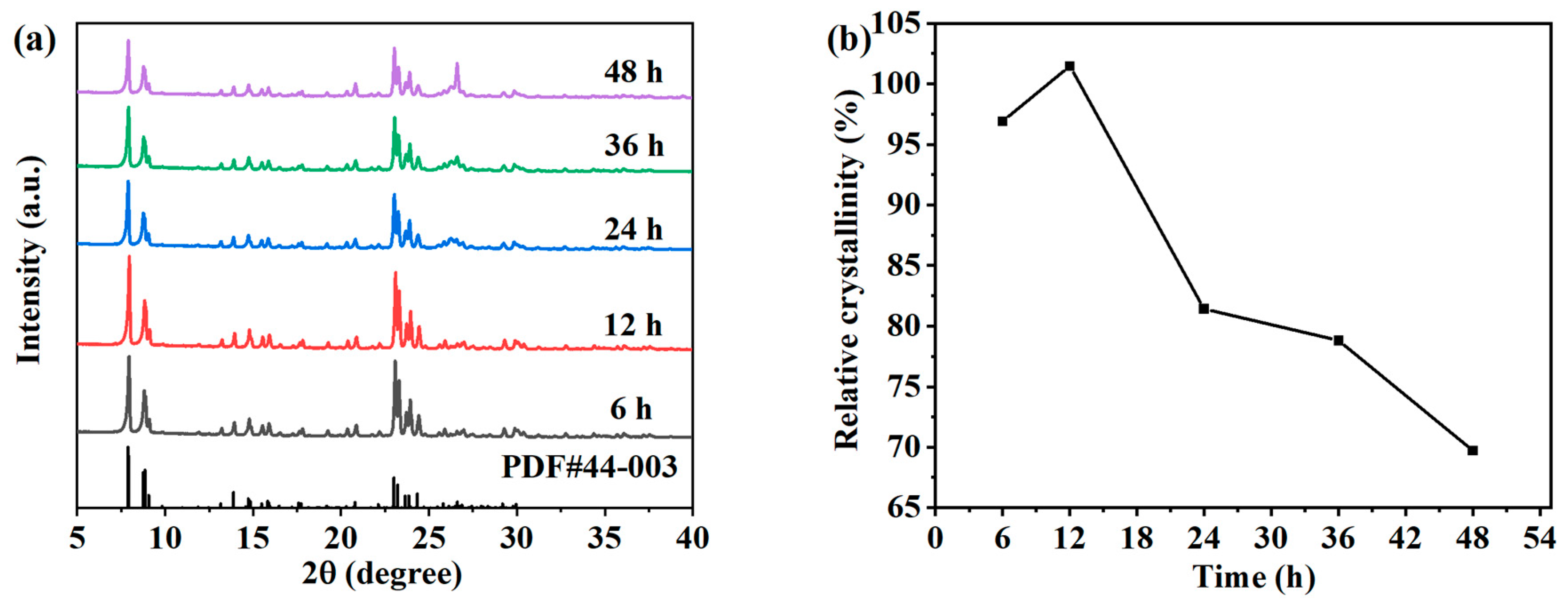
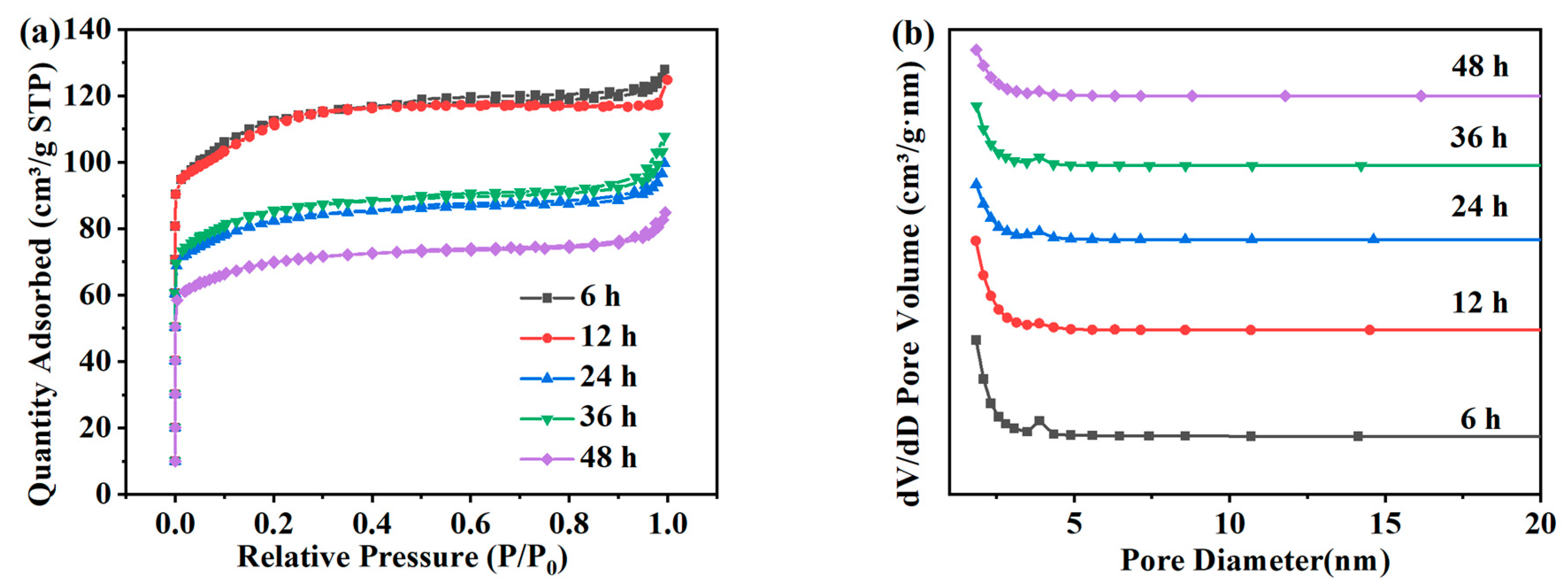

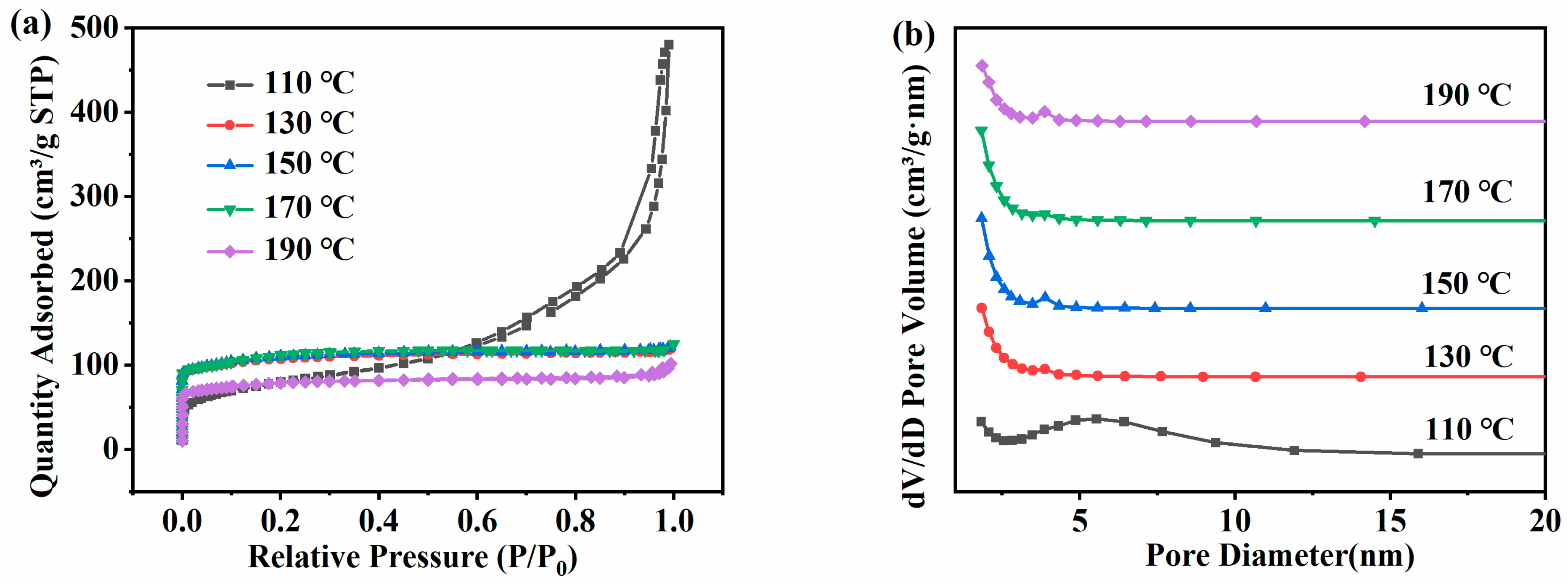

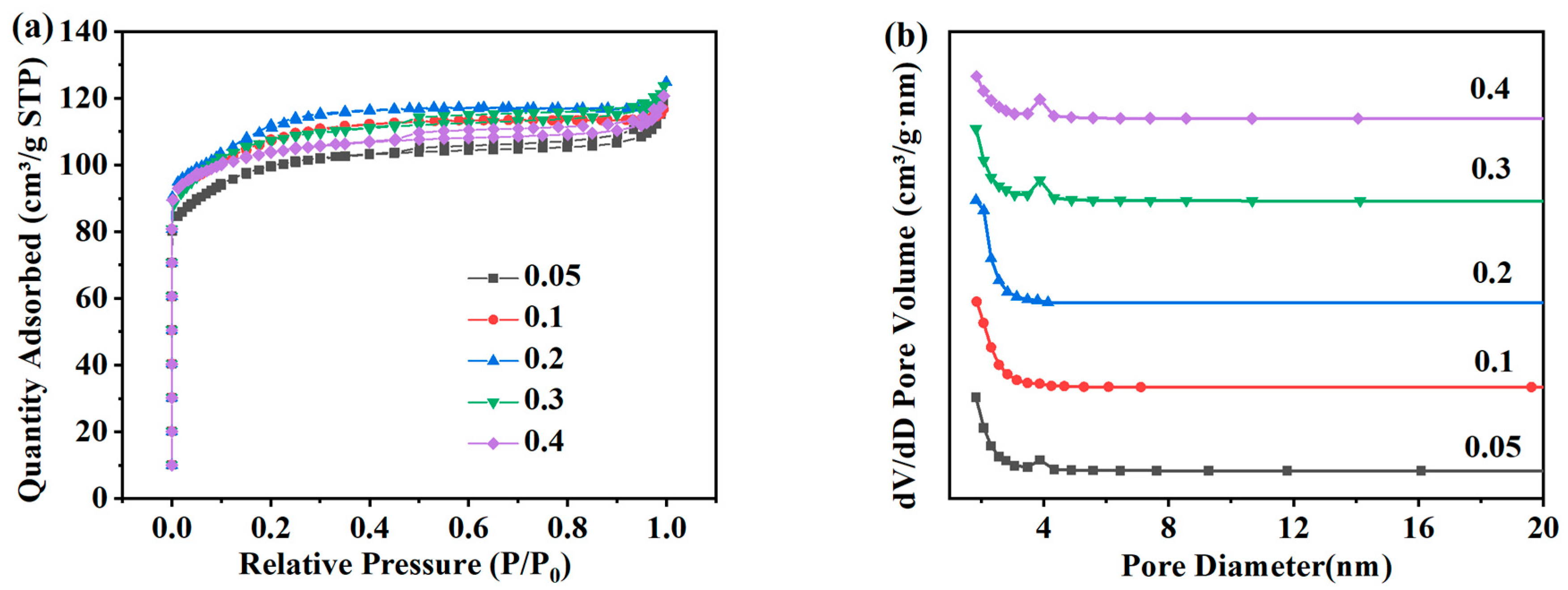

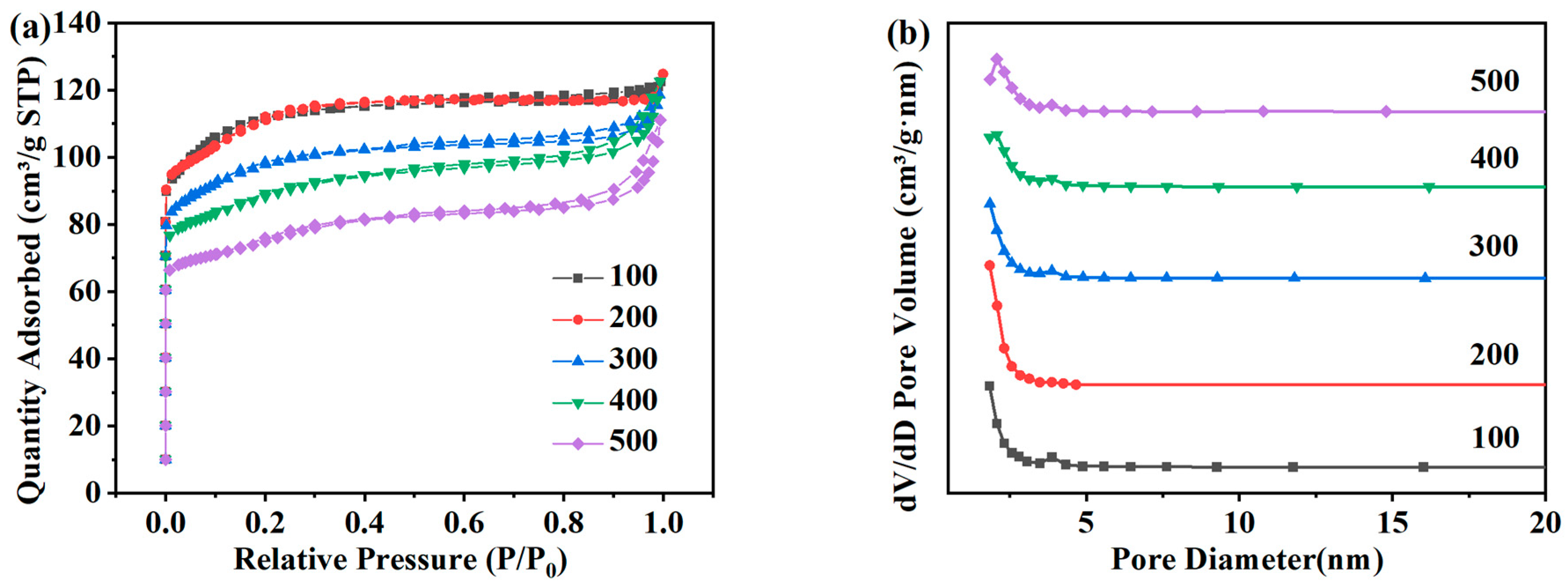
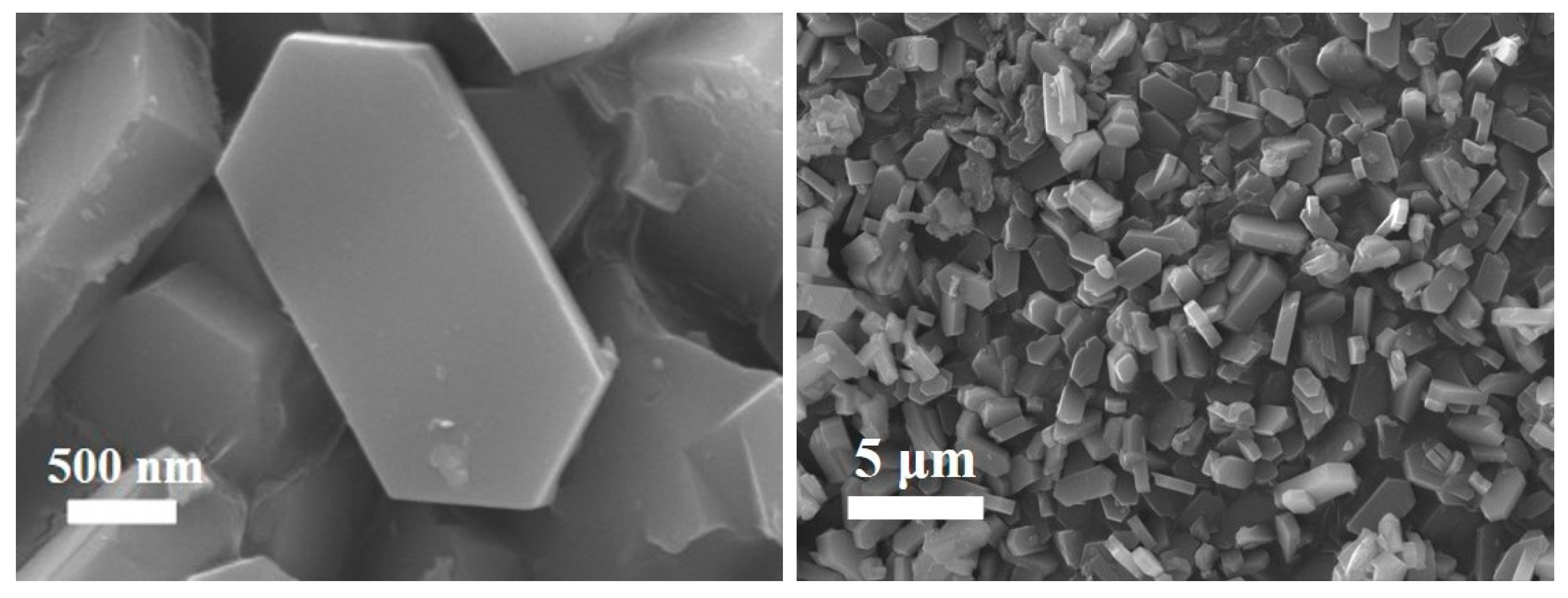
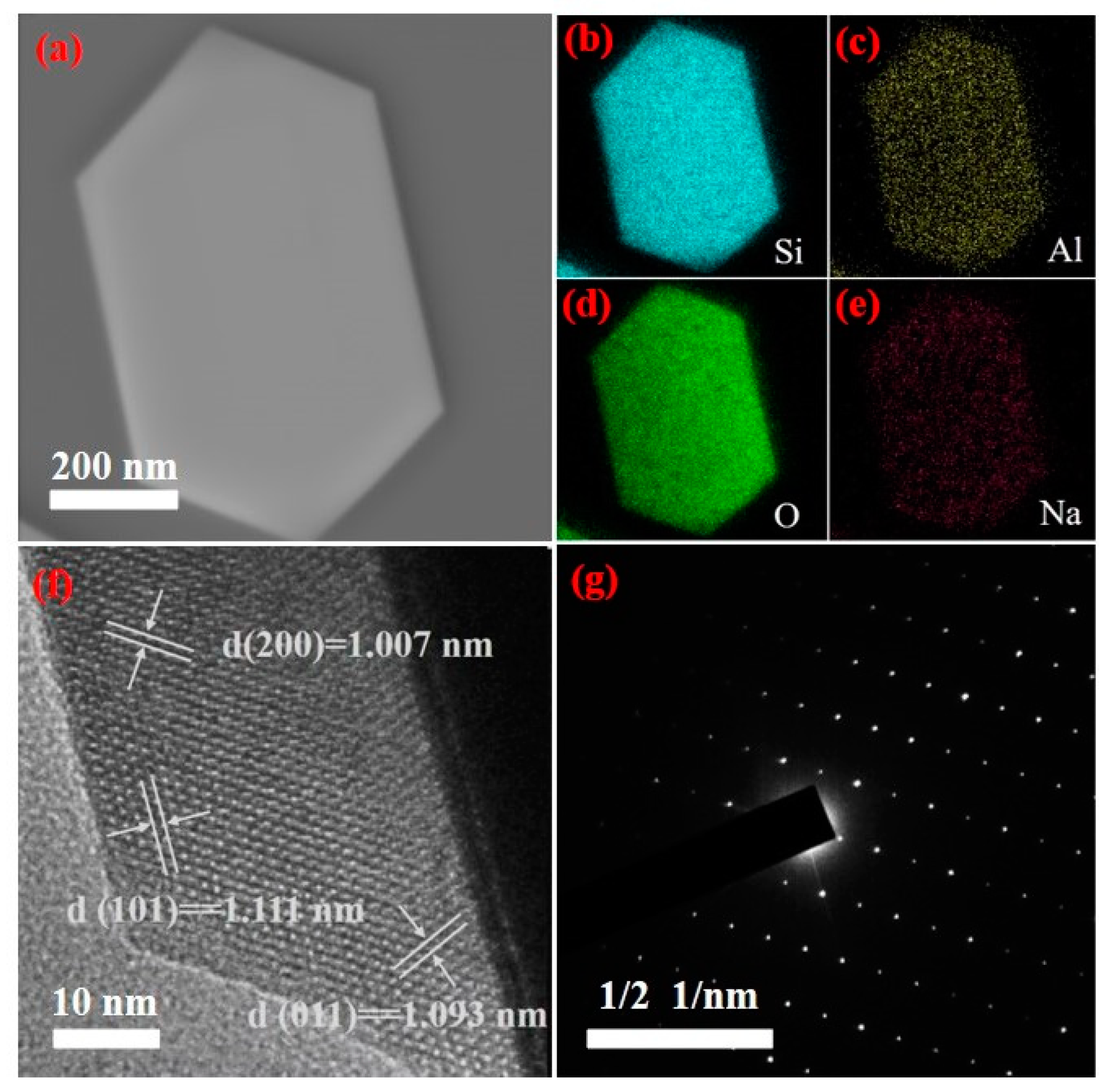
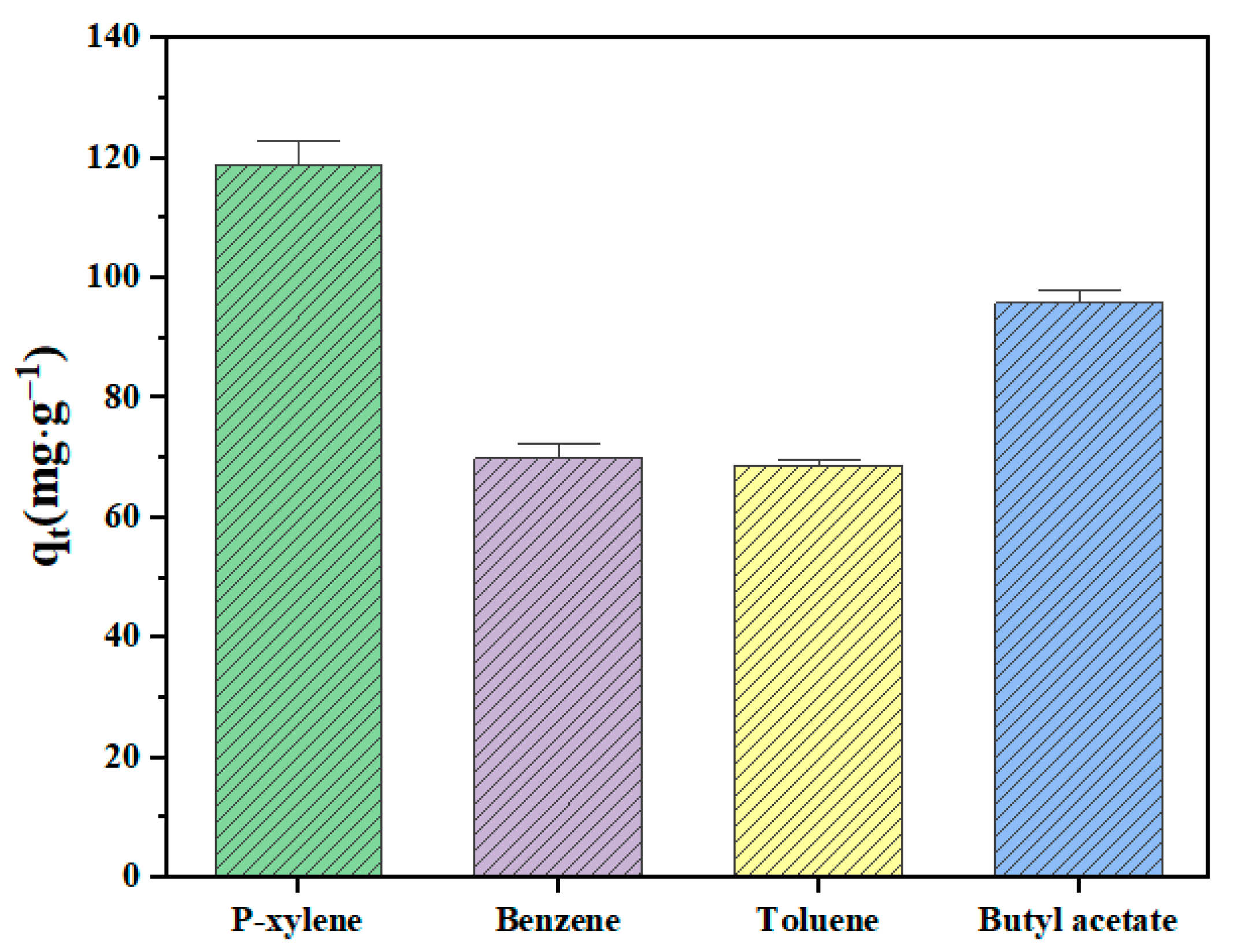
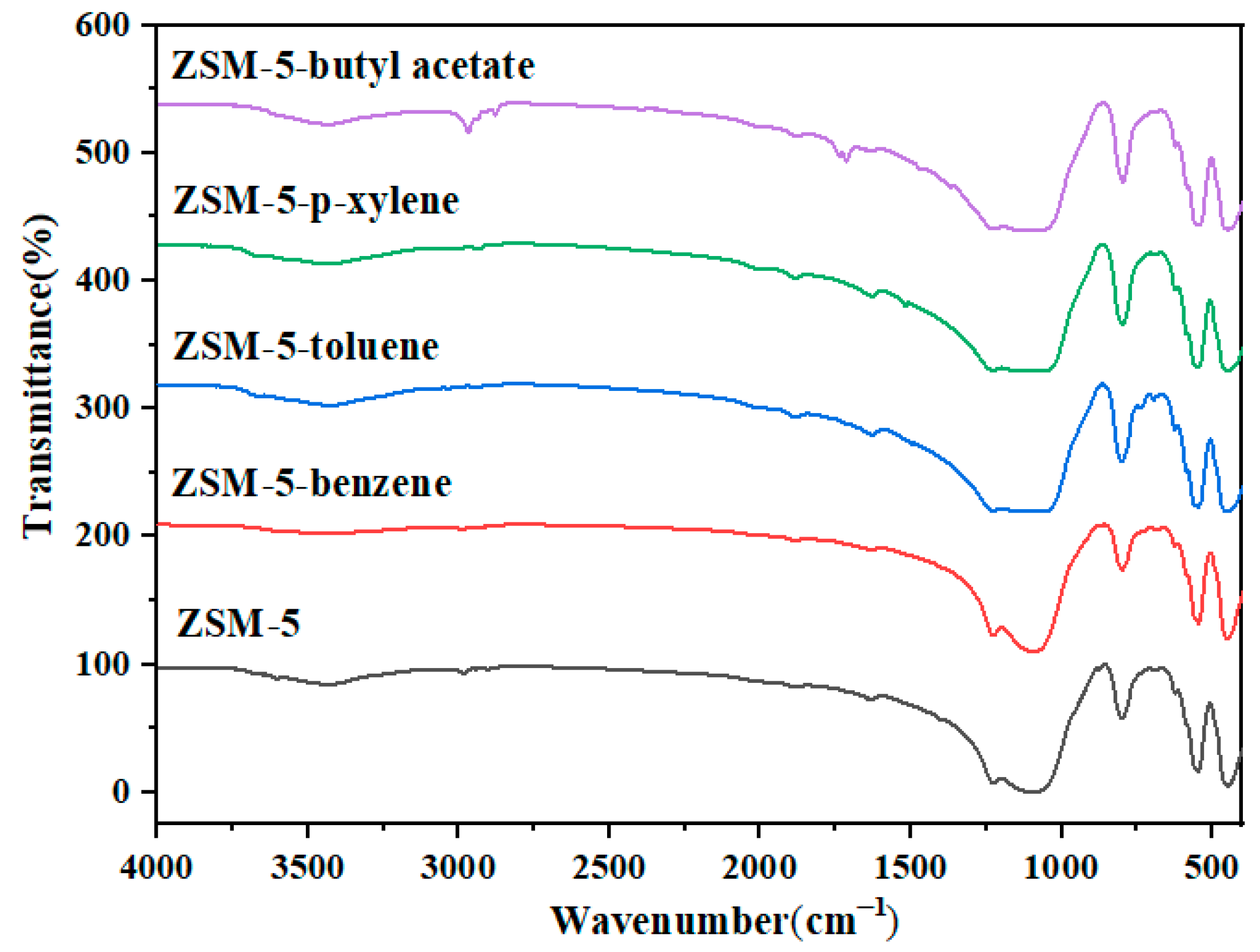
| Elements | Si | Al | Na |
|---|---|---|---|
| Concentration/(g·L−1) | 74.03 | 0.49 | 35.65 |
| Time/ (h) | SBET/ (m2·g−1) | Smicro/ (m2·g−1) | Smeso/ (m2·g−1) | Vmicro/ (cm3·g−1) | Vmeso/ (cm3·g−1) | Vtotal/ (cm3·g−1) | Dpore/ (nm) |
|---|---|---|---|---|---|---|---|
| 6 | 335.16 | 204.25 | 130.91 | 0.115 | 0.083 | 0.198 | 2.36 |
| 12 | 337.48 | 181.52 | 155.96 | 0.103 | 0.087 | 0.190 | 2.26 |
| 24 | 244.59 | 161.33 | 83.26 | 0.090 | 0.064 | 0.154 | 2.52 |
| 36 | 253.09 | 166.94 | 86.15 | 0.093 | 0.074 | 0.167 | 2.63 |
| 48 | 207.69 | 136.35 | 71.34 | 0.076 | 0.055 | 0.131 | 2.53 |
| Temperature/ (°C) | SBET/ (m2·g−1) | Smicro/ (m2·g−1) | Smeso/ (m2·g−1) | Vmicro/ (cm3·g−1) | Vmeso/ (cm3·g−1) | Vtotal/ (cm3·g−1) | Dpore/ (nm) |
|---|---|---|---|---|---|---|---|
| 110 | 267.45 | 48.13 | 219.32 | 0.027 | 0.713 | 0.74 | 11.10 |
| 130 | 318.43 | 213.79 | 104.64 | 0.119 | 0.066 | 0.185 | 2.33 |
| 150 | 330.07 | 208.66 | 121.41 | 0.116 | 0.072 | 0.188 | 2.28 |
| 170 | 337.48 | 181.52 | 155.96 | 0.103 | 0.087 | 0.190 | 2.26 |
| 190 | 234.08 | 147.97 | 86.11 | 0.083 | 0.074 | 0.157 | 2.68 |
| Na2O/SiO2 Molar Ratio | SBET/ (m2·g−1) | Smicro/ (m2·g−1) | Smeso/ (m2·g−1) | Vmicro/ (cm3·g−1) | Vmeso/ (cm3·g−1) | Vtotal/ (cm3·g−1) | Dpore/ (nm) |
|---|---|---|---|---|---|---|---|
| 0.05 | 295.81 | 189.18 | 106.63 | 0.106 | 0.077 | 0.183 | 2.48 |
| 0.1 | 321.94 | 189.93 | 132.01 | 0.107 | 0.073 | 0.180 | 2.24 |
| 0.2 | 337.48 | 181.52 | 155.96 | 0.103 | 0.087 | 0.190 | 2.26 |
| 0.3 | 318.13 | 211.32 | 106.81 | 0.118 | 0.073 | 0.191 | 2.41 |
| 0.4 | 305.12 | 229.82 | 75.3 | 0.127 | 0.06 | 0.187 | 2.45 |
| SiO2/Al2O3 Molar Ratio | SBET/ (m2·g−1) | Smicro/ (m2·g−1) | Smeso/ (m2·g−1) | Vmicro/ (cm3·g−1) | Vmeso/ (cm3·g−1) | Vtotal/ (cm3·g−1) | Dpore/ (nm) |
|---|---|---|---|---|---|---|---|
| 100 | 331.01 | 215.01 | 116 | 0.121 | 0.068 | 0.189 | 2.29 |
| 200 | 337.48 | 181.52 | 155.96 | 0.103 | 0.087 | 0.190 | 2.26 |
| 300 | 292.94 | 178.63 | 114.31 | 0.100 | 0.083 | 0.183 | 2.50 |
| 400 | 270.19 | 161.42 | 108.77 | 0.089 | 0.1 | 0.189 | 2.80 |
| 500 | 229.97 | 138.87 | 91.1 | 0.076 | 0.096 | 0.172 | 2.99 |
| Component | SiO2/(wt%) | Al2O3/(wt%) | Na2O/(wt%) | SiO2/Al2O3 Molar Ratio | Na2O/SiO2 Molar Ratio |
|---|---|---|---|---|---|
| Content | 97.52 | 1.58 | 0.33 | 104.93 | 0.0033 |
Disclaimer/Publisher’s Note: The statements, opinions and data contained in all publications are solely those of the individual author(s) and contributor(s) and not of MDPI and/or the editor(s). MDPI and/or the editor(s) disclaim responsibility for any injury to people or property resulting from any ideas, methods, instructions or products referred to in the content. |
© 2024 by the authors. Licensee MDPI, Basel, Switzerland. This article is an open access article distributed under the terms and conditions of the Creative Commons Attribution (CC BY) license (https://creativecommons.org/licenses/by/4.0/).
Share and Cite
Sun, Z.; Shu, Q.; Zhang, Q.; Li, S.; Zhu, G.; Wang, C.; Zhang, J.; Li, H.; Huang, Z. A Hydrothermal Synthesis Process of ZSM-5 Zeolite for VOCs Adsorption Using Desilication Solution. Separations 2024, 11, 39. https://doi.org/10.3390/separations11020039
Sun Z, Shu Q, Zhang Q, Li S, Zhu G, Wang C, Zhang J, Li H, Huang Z. A Hydrothermal Synthesis Process of ZSM-5 Zeolite for VOCs Adsorption Using Desilication Solution. Separations. 2024; 11(2):39. https://doi.org/10.3390/separations11020039
Chicago/Turabian StyleSun, Zhenhua, Qingxiang Shu, Qikun Zhang, Shaopeng Li, Ganyu Zhu, Chenye Wang, Jianbo Zhang, Huiquan Li, and Zhaohui Huang. 2024. "A Hydrothermal Synthesis Process of ZSM-5 Zeolite for VOCs Adsorption Using Desilication Solution" Separations 11, no. 2: 39. https://doi.org/10.3390/separations11020039
APA StyleSun, Z., Shu, Q., Zhang, Q., Li, S., Zhu, G., Wang, C., Zhang, J., Li, H., & Huang, Z. (2024). A Hydrothermal Synthesis Process of ZSM-5 Zeolite for VOCs Adsorption Using Desilication Solution. Separations, 11(2), 39. https://doi.org/10.3390/separations11020039










